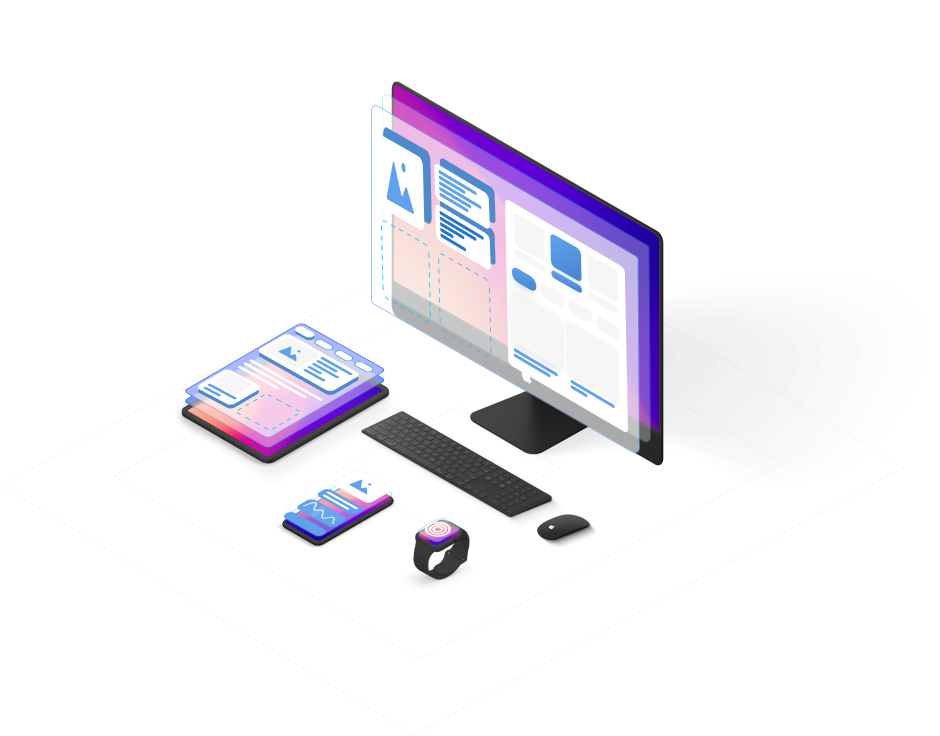Software development is a challenging but still exciting journey that consists of several phases. If you, as a startup founder, want to make your project successful and spend your resources smartly, you must understand the specifics of the life cycle phases of a project and their deliverables.
In this article, we’ll explain everything you need to know about the phases of a project and share bonus tips that will help you manage your project better.
Let’s go!
What Is The Project Life Cycle?
Every project has a beginning and an end, but what happens in between? Even though each project is unique, they go through the same stages. The project life cycle is a framework of the stages that lead your project from the idea to the final goal. Typically, the life cycle of all tech projects looks like this:

It’s important to note that all these phases have three constraints: budget, time, and scope. These three elements are defined at the beginning of the project. Based on their correspondence, we can determine whether each phase of the project was successful or not.

*triple Constraints of each project management life cycle phase
The Project Initiation Phase
Project initiation is the very early stage that is aimed at the investigation of your project's feasibility. In simple terms, it means that you should:
- define the value of your project
- outline the general deliverables you want to get
- think of the actions you should take to achieve the project goals
- assess your resources (time, money, etc.)
Based on this, you can evaluate the capability of your project to move forward. If you want to investigate your opportunities more precisely, you can use the following six criteria:
Important to note: initiation phase of a project is often confused with planning. However, these terms are not interchangeable! To put it simply, initiation is everything that happens before planning. Are you assigning tasks right away? Well, slow down, you’re going too far now. The initiation of the project is only a so-called general overview.
The result of this overview is a specific brief document - Project Charter. It includes the basic info about your project. As practice shows, it can be edited many times before the start of actual work on the project, so our friendly recommendation is not to spend too much time on its creation. Moreover, don’t make it too detailed! It will be enough to describe the following points in 1-2 sentences:
- project general information
- your business needs
- desirable project results
- key stakeholders (people who can have an impact on your project and decision-making)
- project scope
- potential risks
- constraints you should take into account
The Project Planning Phase
Proper project planning is the key to a successful project without excessive stress and losses of resources. During this phase, you together with your tech team should create a detailed roadmap that will lead you to your final goals.

It will be much easier and more convenient to divide all the planning activities into separate areas. Consequently, you will end up planning the project with several documents:
- Project plan – a general document that outlines the main project goals, milestones, and tasks. Usually, this planning is also visualized with a Gantt chart and a Work Breakdown Schedule (WBS)
- Resource plan – your key resources are time, money, and experts needed to implement particular project tasks. When planning a software project, your main goal is to ensure the perfect match for this trio
- Risk management plan – on the initiation stage you have already outlined the potential risks. Now it’s time to evaluate precisely the possibility of their occurrence (you can even use a point system for this). Also, you should make a detailed plan of how you are going to minimize/overcome them.
- Communication plan – how often should you communicate with the tech team? What channels of communication will be used? What is the appropriate frequency and format for the reports? How often should you interact with other stakeholders to run the project smoothly?
- Acceptance plan – here you should set the criteria that are important for you to accept the project deliverables and consider them as successful.
The Project Execution Phase
With a detailed plan and clear strategy, you can move to the execution of a project. It is the most time- and money-consuming phase of the project life cycle. To put it briefly, during this phase your team implements all the previously set tasks while keeping in mind:
- Project goals
- Project scope
- Project scope
- Project budget
- Chosen project management methodology and communication style
What is the sequence of activities that you should expect from your team during the execution of the project? To get the ball rolling, it would be great to set a kickoff meeting. This will help all the team members to sync up and discuss relevant questions. When all the tasks are assigned, your team can start their work on the first milestone (yes, it’s crucial to divide your project into several milestones and move to the result step-by-step).
The number and type of your milestones depend on the specifics of your project. Usually, they are based on the following project execution steps:
Prototyping >> UI/UX design >> backend development >> frontend development >> quality assurance >> project delivery.
The Project Monitoring & Controlling Phase
Project management monitoring and controlling are always conducted simultaneously with the execution phase. Generally, it means a review of current tasks statutes, evaluation of project progress, etc. Proper project control is of crucial importance not just to keep up with deadlines and budgets but also to react quickly if any unexpected circumstances appear. In this case, you can make the necessary project changes and maximize your chances of success.
Of course, the micro-management of the inner processes is the area of responsibility of your tech team. However, this does not mean that your participation is not required at all. You should set up with your team a convenient report/approval format that will keep you in the loop on what’s going on.
The end goal of this phase of project life cycle is to make sure that all the planned deliverables are completed with high quality and within the initially set time, scope, and budget. Also, it’s important to fix that these deliverables were accepted by the client (you and all the stakeholders).
The Project Closure Phase
Congrats, it’s a project closure! You did a great job! However, before starting celebrations, you need to summarize the results and make a project closure report. It’s a document that outlines the achievements of your team and recommendations for further improvements.
Also, here is a checklist for project closure:
- Revisit your project plan to make sure that all the goals were completed
- Get all the project documentation, reports, and access data
- Get the final approval from all the stakeholders
- Set a meeting with your team to get the final presentation of your project and discuss formal organizational questions
- Get feedback from the core executive team: the gained experience is priceless, so discuss with them the results of testing ideas and hypotheses, what works well for your project, and what problems they faced. It's a good material for learning from your mistakes.
Friendly reminder: closure of a project it’s a great opportunity to praise your team. Be motivational!
Learn more about cases we made
Here you can find examples that might be perfect fitted to your project or to the industry you work with
Learn more about cases we made
Here you can find examples that might be perfect fitted to your project or to the industry you work with
Bonus. Important things every founder should know before starting a project.
Software development can be a challenging journey, especially when it comes to app development for startups. So if you want to move smoothly through all the phases of a project, you should keep in mind the following recommendations:
- Be flexible: even if you have already built your startup strategy, you have to adapt to the circumstances and be ready to pivot your business.
- Remember: you don’t build a product for your satisfaction only. Your main goal is to solve the pains of your target audience. Don’t hesitate to spend your time and money on its investigation.
- It’s much more effective to build your product step-by-step rather than invest in full-fledged development. Minimum Viable Product (MVP) is the best option for software development for startups. You can start with the most basic features, test the first version of your app and get feedback from real users, make the necessary improvements, attract more investors, and even get first profits and continue development at the same time!
- Branding for startups is a must. Your product is new to the overcrowded market, so it’s not enough to be “good”. You should be outstanding and outpace the competitors! So we recommend planning your marketing and branding budget at the very beginning.
- You can’t move forward without like-minded people! The startup is always about passionate teamwork. It’s better to spend more time looking for dedicated team members for your project rather than hire developers that don’t believe in your project idea's success.
Bonus. What mistakes should be avoided during the project life cycle?
We’re only human, so project lifecycle management is impossible without small emergencies. However, some of the typical pitfalls can be avoided, if you read the pieces of advice below carefully:
- Unclear goals set at the beginning will lead to confusing results. If it’s hard for you to outline one precise goal, it will be much better to divide it into several smaller targets. And, of course, don’t forget to evaluate whether your goals are realistic (based on the available resources, market conditions, and other crucial circumstances).
- Don’t be shy to engage all the stakeholders in the project development. Their poor involvement in milestone development may lead to disappointments, misunderstandings, frustration, and even project failure.
- Software development for startups is about continuous improvements. Without reflection and progress evaluation after each milestone, you can end up with a product that will have no demand on the market. Don’t underestimate the importance of progress reports from your team!
- Still don’t have a scaling plan? Skyrocketing is a dream of every startuper. However, you may find yourself a bit confused if you have to scale too soon or too fast. Where to find resources? How to manage the workflow? A scaling plan will help you find the answer to these and many other questions and keep your startup functioning smoothly.
Resume
Hope this article helped you get a basic understanding of the project lifecycle. If you need more detailed consultations on this topic or want to create an application for startup, feel free to contact our DreamX team!

Alex Korshykov
CEO, DreamX
We are DreamX
DreamX is a full-cycle design and development company that works with startups and scales existing digital projects.






